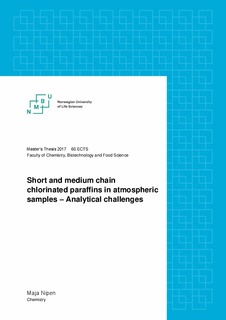| dc.contributor.advisor | Kallenborn, Roland | |
| dc.contributor.advisor | Bohlin Nizzetto, Pernilla | |
| dc.contributor.advisor | Schlabach, Martin | |
| dc.contributor.advisor | Halse, Anne Karine | |
| dc.contributor.author | Nipen, Maja | |
| dc.date.accessioned | 2017-08-30T11:52:34Z | |
| dc.date.available | 2017-08-30T11:52:34Z | |
| dc.date.issued | 2017 | |
| dc.identifier.uri | http://hdl.handle.net/11250/2452405 | |
| dc.description.abstract | Chlorinated paraffins (CPs) is a group of organic compounds consisting of chlorinated n-alkanes of varying chain length (C10-C30) and degrees of chlorination (40 to 70% by weight). The CPs are generally divided into three groups; short-chain (SCCPs, C10-13), medium-chain (MCCPs, C14-17) and long-chain (LCCPs, C18-30). CPs are produced in large volumes and are used as plasticizers in plastics and rubbers, as additives in paints, adhesives and sealants, as metal working fluids and as a flame retardant in textiles and polymers. They have been found to be persistent in the environment, and show toxicity in aquatic ecosystems. This study evaluated an analytical method for quantification of SCCPs and MCCPs in air samples with regard to blank contributions from various pathways, including storage of sampling material, sample collection in the field, reagents used, and the laboratory environment. In addition, instrumental analysis using gas chromatography quadropol time-of-flight (GC/Q-TOF) mass spectrometry (MS) was evaluated, and compared to an established method using a sector MS instrument. The GC/Q-TOF instrument gave comparable results to the sector instrument in the analysis of air samples. The performance of the two instruments was also compared using sediment, biota and dust samples from an interlaboratory study. The results were comparable for all samples with exception of the sediment samples, where the sector instrument indicated higher CP levels. The GC/Q-TOF gave more precise results on repeated measurements.
Recovery of the different CP homologue groups was investigated as part of the study to evaluate if their distribution in the original sample stays intact after sample extraction and preparation. The homologue group distribution was found to be intact.
The investigation of CP contamination sources showed that the indoor laboratory environment contains considerable amounts of CPs, suggesting that precautions needs to be taken in the handling of samples. The highest indoor level of SCCPs, measured using passive air samplers, was found in a lab at 55.5 ng/m3, while the highest MCCP level was 0.3 ng/m3 from the same lab. In dust/organic film samples the highest level of SCCPs found was 2856 ng/m2, while the highest MCCP level was 965 ng/m2. Considerable amounts of CPs were also found in products used in the lab, there are however suggestions that CP contamination from dust could be a factor in this find. No systematic contamination sources related to storage of sampling material, sampling in the field or the reagents used could be found. | nb_NO |
| dc.description.abstract | Klorparafiner (CPs) er en gruppe organiske stoffer som består av klorerte n-alkaner av varierende kjedelengde (C10 til C30) og kloreringsgrad (40 til 70 vekt %). CPs er generelt delt inn i tre grupper; kortkjedede (SCCPs, C10 til C13), mediumkjedede (MCCPs, C14 til C17) og langkjedede (LCCPs, C18 til C30). CPs produseres i store volumer, og benyttes som plastmyknere i plast og gummi, som tilsettingsstoffer i maling, festemidler og tettningsmasser, som skjærevæske i metallarbeid og som flammehemmer i tekstiler og polymerer. De er persistente i miljøet, og har vist seg å være giftige i akvatiske miljø. I denne studien evalueres en analytisk metode for kvantifisering av SCCPs og MCCPs i luftprøver med hensyn på kontaminering fra ulike kilder, inkludert lagring av prøvemateriale, prøvesamling i felt, reagenser som benyttes, og innemiljø i laboratoriet. I tillegg evalueres analysen med et gass kromatografi quadropol time-of-flight (GC/Q-TOF) masse spektrometer (MS), og dette sammenlignes men en etablert metode der et sektor MS instrument benyttes. GC/Q-TOF instrumentet viste resultater som var sammenlignbare til sektorinstrumentet ved analyse av luftprøver. Instrumentene ble også sammenlignet ved analyse av sediment, biota og støvprøver fra en interlaboratoriestudie. Disse resultatene var sammenlignbare for alle prøver, med unntak av sediment, der sektorinstrumentet viste høyere resultat. GC/Q-TOF instrumentet viste mer presise resultater ved repeterte målinger.
Gjenvinningen av de ulike homologgruppene i SCCPs og MCCPs ble vurdert som en del av studien, for å undersøke om distribusjonen av disse i en prøve forholder seg intakt etter prøveopparbeidelse. Homologgruppedistribusjonen ble funnet å holde seg intakt.
Undersøkelsen av CP kontamineringskilder viste at innemiljøet i laboratoriet inneholder betydelige mengder CPs, noe som innebærer at forholdsregler bør tas under håndtering av prøver. Det høyeste nivået av SCCPs funnet i inneluft i laboratoriet ved hjelp a passiv prøvetaker var 55.5 ng/m3, og høyeste nivå av MCCP var 0.3 ng/m3 fra samme lab. I prøver av støv/organisk film var det høyeste nivået funnet 2856 ng/m2, mens det for MCCP var 965 ng/m2. Betydelige mengder SCCP ble også funnet i produkter benyttet på laben, men det er indikasjoner på at kontaminering fra støv kan være en faktor i dette funnet. Ingen systematiske kontamineringskilder knyttet til lagring av prøvemateriale, prøvetaking i felt, eller reagenser benyttet ble funnet. | nb_NO |
| dc.language.iso | eng | nb_NO |
| dc.publisher | Norwegian University of Life Sciences, Ås | nb_NO |
| dc.rights | Attribution-NonCommercial-NoDerivatives 4.0 Internasjonal | * |
| dc.rights.uri | http://creativecommons.org/licenses/by-nc-nd/4.0/deed.no | * |
| dc.subject | Chlorinated paraffins | nb_NO |
| dc.subject | Quadrupole time-of-flight MS | nb_NO |
| dc.subject | Sample/blank contamination | nb_NO |
| dc.subject | Indoor enviroments | nb_NO |
| dc.subject | Air sampling | nb_NO |
| dc.title | Short and medium chain chlorinated paraffins in atmospheric samples : analytical challenges | nb_NO |
| dc.type | Master thesis | nb_NO |
| dc.subject.nsi | VDP::Mathematics and natural science: 400::Chemistry: 440::Organic chemistry: 441 | nb_NO |
| dc.subject.nsi | VDP::Mathematics and natural science: 400::Chemistry: 440::Analytical chemistry: 445 | nb_NO |
| dc.subject.nsi | VDP::Mathematics and natural science: 400::Chemistry: 440::Environmental chemistry, natural environmental chemistry: 446 | nb_NO |
| dc.source.pagenumber | 108 | nb_NO |
| dc.description.localcode | M-KJEMI | nb_NO |

